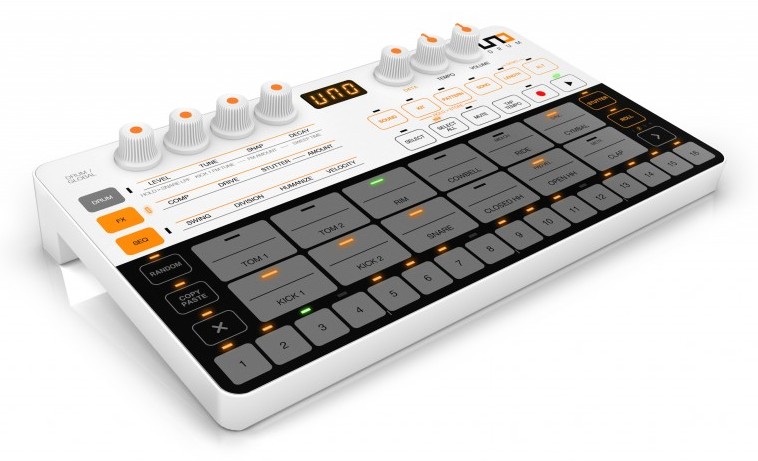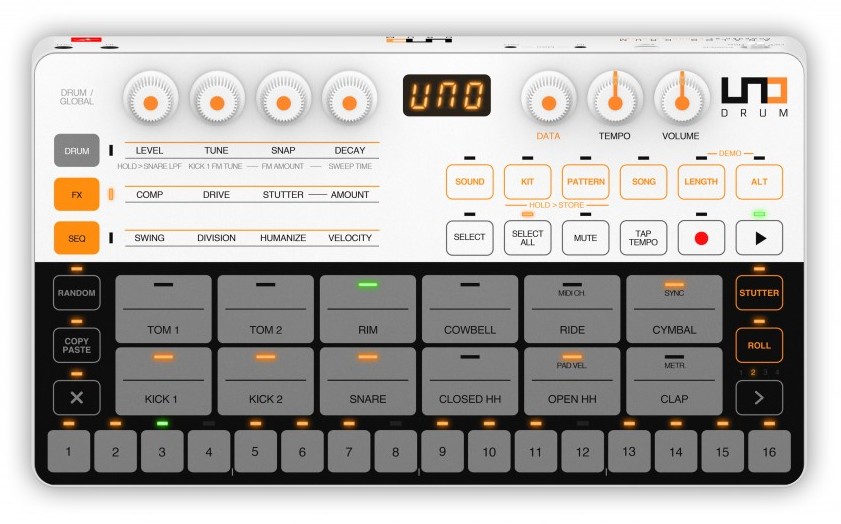New Gear Review: UNO Drum by IK Multimedia
Though it’s become incredibly crowded, Italian music manufacturers IK Multimedia jumped into the synth swimming pool with both feet back in 2018 with their analog-driven UNO Synth. We reviewed their first effort and took a liking to the plastic-encased, dual-oscillator instrument, which featured a multi-mode filter, variable wave shaping, and a resourceful arpeggiator.
Following up in the same format but with a white case is the UNO Drum, which, like its sibling, pairs analog circuitry with some digital components. Also like the UNO Synth, the UNO Drum is made in conjunction with fellow Italians Soundmachines, who reportedly worked on the analog component of both machines.
The UNO Drum initially came out in mid 2019, but importantly, IK Multimedia recently revealed a free editor for the machine which greatly expands its capability. So just how does the UNO Drum fare?
Features
For an incredibly lightweight device, the UNO Drum’s feature set is fairly extensive. The bottom of the unit is made up of two areas that are touch capacitive—a sixteen step sequencer on the bottom and a section of twelve pads that are used to trigger the sounds. Each pad has two zones for two different velocity levels, though this can be disabled if desired.
Editing the sounds is done with a matrix similar to the UNO Synth, though there is only one row of parameters that is relevant to changing the sounds of the instruments themselves—the rest are all global parameters. These are controlled by endless encoders, which work well to prevent knob jumping. Besides the single row of knobs on the top of the UNO Drum, there is a tempo knob and a main volume knob. The output is on an 1/8” jack and there are mini MIDI in and out jacks as well; the UNO Drum does come with the proper MIDI adapters. The unit can be powered via batteries or USB.
As mentioned, there are twelve instruments total, each of which can be triggered via their own touch capacitive pad. Six of these instruments are analog circuit-derived, and the sound is weighty and thick. Each instrument has a variety of PCM sounds to choose from that fit within the instrument category (i.e. five variations of rim-shots). Interestingly, these PCM samples are 32kHz and 12-bit, so the sound has a vintage flavor inherently.
IK Multimedia recently introduced something they are calling “Drum Anthology Libraries.” These are groupings of PCM samples that are modeled after classic drum machines, though it’s important to note that these are just emulations and not samples of the iconic drum machines themselves.
The UNO Drum stores 100 preset kits and 100 patterns; the patterns it comes shipped with show off a nice range of rhythms and make good use of the swing feature, which can be applied per pattern.
In Use
Despite its plastic case and somewhat diminutive appearance, using the UNO Drum is both intuitive and fun. The sequencer is fairly flexible, with 64 steps, the ability to change length on the fly, and record parameter changes into the sequencer, as has become en vogue these days. There are also controls for randomize, which works on either a per instrument or per pattern basis, and copy/paste functionality, which makes it quick to copy sequences between instruments, an otherwise tedious task with 64 possible steps.
Dedicated buttons for two performance-oriented features greatly increase what the UNO can do—stutter and roll. Both are momentary effects, meaning the pad has to be held down for them to be applied. Stutter works globally on the pattern and has adjustments for both type (ten variations total) and amount applied. Roll works on the currently selected instrument, though it’s possible to quickly select all of the instruments with the dedicated “Select All” button. There are several variations of rolls and fills to choose from; these can be selected when the button is held down, and makes for a lot of fun in real-time jam situations.
Velocity can be modified per step in the Elektron way of holding down a “trig” and changing the value; this does aid in programming more intricate patterns. Furthermore, it’s possible to lock the tempo knob, which is handy. Due to the fact that it’s placed so close to the volume knob, it’s very easy to accidentally move it and change the tempo of your beat.
It’s nice to see that manufacturers are thinking about the end result with drum machines, and to that end, IK Multimedia have included compression and an analog drive circuit on the UNO Drum. Both are adjustable and sound great. Just like on the Arturia DrumBrute Impact, using the UNO with and without drive is like using two different machines. Add both drive and compression to the analog circuitry, and you are suddenly in the kind of territory that is usually reserved for drum machines that have already made it onto a thousand records.
One final addition to the UNO Drum that is going to please a lot of users is an easy-to-use “Song” mode. Up to 64 patterns can be strung together; this is done by holding down a step in the sequencer and selecting whichever pattern you’d like.
While it wasn’t ready at the time of the UNO Drum’s release, IK Multimedia has since released a free editor for the drum machine that works on both Mac/PC and iOS devices. This editor connects to the UNO Drum via USB and communicates two ways with the unit—any knob tweak on the machine is reflected in the editor.
More importantly, the editor lays every single available parameter out on a single screen, as well as providing visual representations for all of the patterns on the machine. Furthermore, it’s possible to store and swap both preset kits and patterns using the editor, which works both standalone and as a plugin in your favorite DAW. If you’re considering the UNO Drum as a live tool, using it in conjunction with the editor is going to make you reconsider its worth as a studio tool as well.
To Be Critical
There were a few minor niggles we had with the UNO Drum, and one more major one.
First, the sixteen pads do have two velocity levels, though it was pretty hard to accurately play them. You’d be better off using an external controller if you’d like to play in your beats with more accuracy.
The 1/8” output and MIDI breakout cables don’t necessarily inspire the most confidence when using the UNO Drum on stage. The analog sounds don’t offer a ton of sonic flexibility, there are no effects, and there is no way to send instruments out via separate outputs, so that will limit your results.
But the most relevant critique of the UNO Drum seems to be mentioned by a few earlier users. Using the instrument when powered by a computer USB port seemed to introduce some sort of high-pitched noise into the sample engine. IK has confirmed that this is a known issue, due to a ground loop caused by computer USB power. If you don’t mind using a USB wall adapter, switching to an alternate power source, or other simple workarounds, this can be remedied. While this wasn’t a deal breaker sonically, as the machine tends to have a lo-fi character anyway, it certainly limits the recordings that you’re going to be able to get out of the UNO Drum if using USB computer power. However, if you’re pumping it through an old Mackie mixer and getting noise from other sources anyway, you probably won’t be bothered.
Summing it Up
Priced at $199, there are quite a few nice touches that place the UNO Drum in a class where it could be competing with much higher-priced machines—randomize, compression, drive, pattern length flexibility, and more. Considering its lightweight size and impressive MIDI spec, it makes a handy rhythm source for when you want to quickly program a beat and don’t feel like breaking out your DAW.
And while the IK Multimedia UNO Drum started life as a fairly stripped down machine, the release of the computer editor as both standalone and plugin means the ease of use is greatly expanded. While its sound engine isn’t going to win awards for fidelity and crispness, the UNO Drum would fit perfectly into either your live or studio setup, as long as you don’t mind its vintage character.
Leo Maymind is a producer, DJ, and writer living in Los Angeles, CA. He is obsessed with sound, and you can reach him at lmaymind@gmail.com.
Please note: When you buy products through links on this page, we may earn an affiliate commission.









[…] Though it’s become incredibly crowded, Italian music manufacturers IK Multimedia jumped into the synth swimming pool with both feet back in 2018 with their analog-driven UNO Synth. We reviewed their first effort and took a liking to the plastic-encased, dual-oscillator instrument, which featured a multi-mode filter, variable wave shaping, and Read more… […]